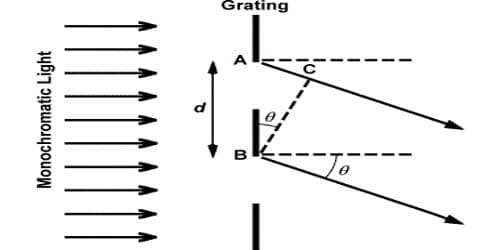Experiment to determine the wavelength of monochromatic light using a plane transmission grating
The wavelength of a spectral line can be very accurately determined with the help of a diffraction grating and spectrometer.
Apparatus: Diffraction Grating, Monochromatic Light Source, Spectrometer
The spectrometer is set with its collimator towards the source of light. Initially, all the preliminary adjustments of the spectrometer are made. The telescope is brought in line with the collimator. The slit of the collimator is illuminated by a monochromatic light, whose wavelength is to be determined. The width of the slit is made sufficiently narrow. The telescope is brought in line with the collimator to view the direct image. The eyepiece of the telescope is adjusted so that cross wires are distinctly visible. The given plane transmission grating is then mounted on the prism table with its plane is perpendicular to the incident beam of light coming from the collimator. Using a glass prism, the optical leveling of the prism table is done. The telescope is slowly turned to one side until the first-order diffraction image coincides with the vertical cross wire of the eyepiece. The reading of the position of the telescope is noted (Figure).
 Fig: Diffraction of monochromatic light
Fig: Diffraction of monochromatic light
Similarly, the first-order diffraction image on the other side is made to coincide with the vertical cross wire and corresponding reading is noted. The difference between the two positions gives 2θ. Half of its value gives θ, the diffraction angle for the first-order maximum. The wavelength of light is calculated from the equation λ = sinθ/Nm. Here N is the number of rulings per meter in the grating. It is taken care that adjustments of the spectrometer are not disturbed afterward during the experiment.
Method:
(1) Set up apparatus as shown in the diagram.
(2) Adjust the spectrometer as follows:
- make sure cross threads are in focus and upright,
- focus on a distant object to ensure parallel beams,
- adjust the width of the slit to get a narrow beam.
(3) Place the diffraction grating vertically in the holder.
(4) Look through the eye-piece which is straight in front of the grating to find the zero-order images.
(5) Move the telescope to the left and right to find the 1st order image.
(6) Measure and record the readings on the circular scale/vernier scale.
(7) Repeat steps 5 and 6 for the corresponding 1st order image on the right.
(8) Calculate the average value of the wavelength using the formula: λ = dsinθ/n
Here, λ = wavelength, θ = degrees and n = order image.
PRECAUTIONS:-
- The prism table should be properly leveled.
- Make sure diffraction grating is standing vertically
- The grating surface is never touched while handling it.
- Adjust the eyepiece until the cross threads are clearly in focus
- The prism table should not be disturbed while rotating the telescope to receive images of different orders.
- Set collimator so that only parallel rays come through.












